
- Ankarafantsika National Park protects an oasis of dry forest in northern Madagascar, providing vital habitat to critically endangered lemurs and other wildlife.
- In September and October, fires raged across the southern portion of the park, burning more than 40 square kilometers (15 square miles).
- While fire is a natural part of Ankarafantsika’s ecosystems, researchers say fire on this scale is “unprecedented” and amounting to a “conservation crisis.”
- The fires are also drying out the landscape and reducing neighboring communities’ crop yields, which conservationists warn could have knock-on effects for nearby forests as people turn to natural resources to survive.
Historically, the dry forests of western Madagascar did not receive as much interest from conservationists as the country’s eastern rainforests. One study published in 2015 in International Forestry Review found that the dry forests had been “neglected.” In recent years, they have faced increasing threats. For example, Menabe Antimena Protected Area, in the southwest, has faced overwhelming deforestation pressure from corn farmers.
Now a dry forest in Madagascar’s northwest is also threatened. Ankarafantsika National Park, the beating heart of one of the country’s largest dry forests, is home to iconic lemur species such as the critically endangered Coquerel’s sifaka (Propithecus coquereli), as well as about a dozen communities that rely on its resources. For many decades, the park was relatively well protected, but since 2016 it’s faced a serious threat: too much fire.
This year’s fires were the worst yet. Two conflagrations in September and October — peak fire season — together burned more than 40 square kilometers (about 15 square miles), an area that would cover two-thirds of Manhattan. Hundreds of local people used water bags to fight the fires, putting them out after many days in each case. But the damage was severe.
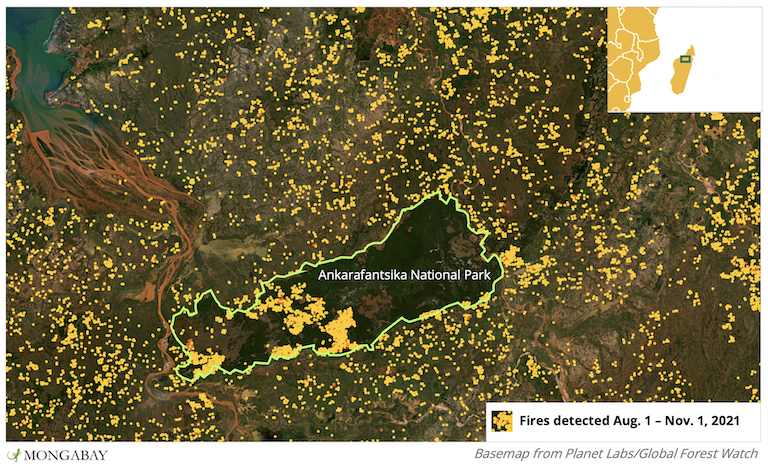
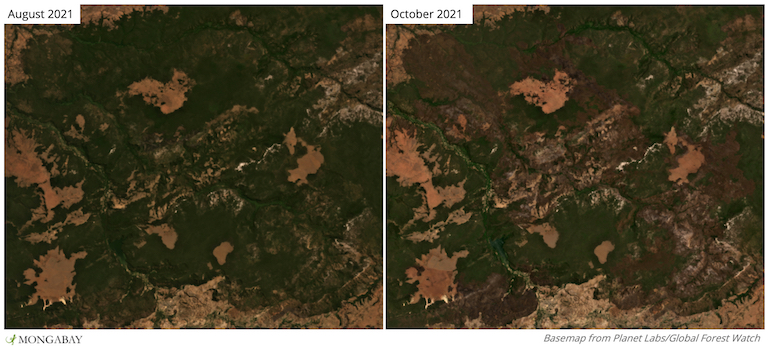
“I am actually shocked after seeing the recent satellite images,” Dominik Schüßler, a research associate and doctoral student in conservation biology at the University of Hildesheim in Germany who’s currently conducting field work in Madagascar, told Mongabay, calling this season’s forest clearance “unprecedented” for Ankarafantsika.
While fires are a natural part of dry forest ecosystems, the scale of these fires damages habitats and threatens the well-being of wildlife and people in the area, scientists say.
“Fire belongs there, but it’s a hard thing to manage — like trying to stop the wind,” Travis Steffens, an evolutionary anthropologist at the University of Guelph in Canada and executive director of Planet Madagascar, a conservation group that works in the park, told Mongabay. “We’re basically seeing a conservation crisis butt up against a humanitarian crisis,” he said.
Burning up, drying out
If dry forests were neglected, Ankarafantsika was an exception: it was among the first protected areas that the colonial government established in the 1920s, and it’s been a relative success story.
Though deforestation has been rampant in Madagascar for the past seven decades or more, Ankarafantsika did not suffer as much as other areas.

From 1996 until 2006, the park lost less than 0.1% of forest cover per year on average, according to a three-volume compendium of Madagascar’s protected areas published by the University of Chicago Press in 2018. Likewise, Schüßler’s research indicates that Ankarafantsika’s forest cover has been relatively stable since at least 1990, with about two-thirds to three-quarters of the park covered.
However, things began to change a bit after a 2009 coup d’état in Madagascar, sending the park’s deforestation rate above 1% — a more than tenfold increase — and the trend has accelerated since then. The park had a major fire season in 2016, and in 2019 the situation got so bad that park managers called for international assistance.
Yet now the park is seeing even more damage. In the last 15 months, it’s lost about 90 square kilometers (about 35 square miles) of forest, according to Schüßler, who’s preparing an article that uses this data. That amounts to 6.6% of the park’s surface area. The “vast majority” of that loss came in 2021, he said.
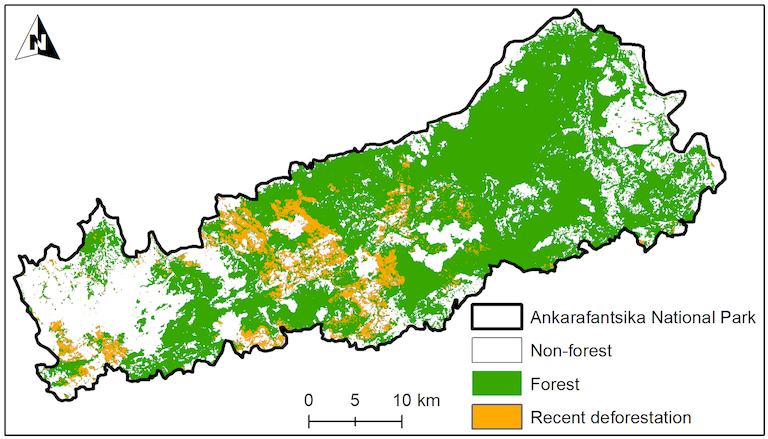
This year’s two major fires were a big part of that equation, and there were many dozens of smaller forest fires, as well. Fire is the main threat to Ankarafantsika’s people and ecosystems, several experts said.
“Fire doesn’t necessarily cause deforestation,” Steffens said. “[The forest] can recover. But fire does alter forest structure. It can change the landscape if it’s frequent.”
Most local people are rice or cassava farmers, and the fires reduce their yield. They dry out the area, decreasing water availability.
“To grow anything, they need water,” Mamy Razafitsalama, In-Country Director of Planet Madagascar, told Mongabay. “The absence of the forest reduces water production and affects their agriculture.”
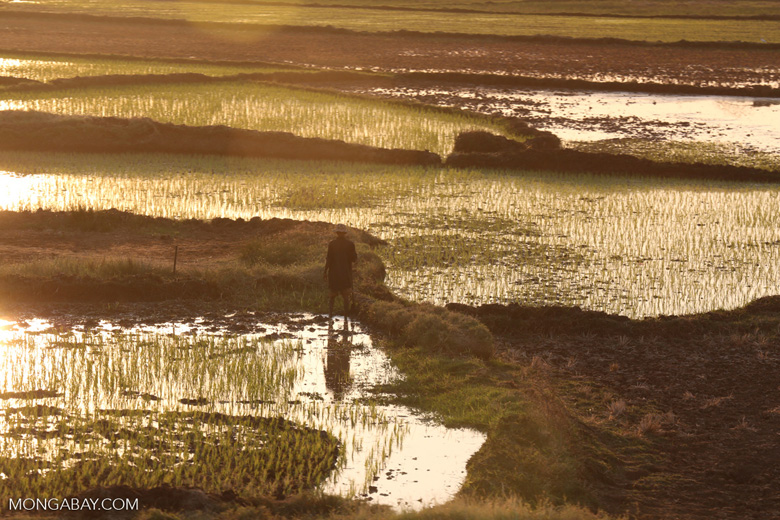
Fires also degrade the soil, causing erosion and covering fields in sand, said Ando Rakotomamonjy, a doctoral student in natural ecosystems at the University of Mahajanga and a conservation project manager in the park. This is part of a vicious cycle in which reduced yields lead to further exploitation. “If they can’t cultivate the rice, they find another way to survive, by [for example] producing charcoal,” she said. Charcoal is made by burning wood in a low-oxygen environment to remove moisture, and often comes at the expense of nearby forests.
The fires also put wildlife at risk. There are eight lemur species, most of which are found only in the park and surrounding areas. In addition to the Coquerel’s sifaka, of which there are an estimated 47,000 individuals in the park, these include threatened species such as the mongoose lemur (Eulemur mongoz), the Milne-Edwards’ sportive lemur (Lepilemur edwardsi), and the golden-brown mouse lemur (Microcebus ravelobensis), which is the smallest species of lemur, weighing only two to three times as much as a mouse. The park is also home to more than 140 bird species, including the critically endangered Madagascar fish eagle (Haliaeetus vociferoides), which can often be seen at Lake Ravelobe.


While the most pressing concern for wildlife is habitat loss and fragmentation, the fires also pose immediate threats. After the October fire, Rakotomamonjy found the burned remains of a lemur and a snake.
What’s causing the fires?
This year’s biggest fire started on September 5 and lasted more than a week, burning through about 32 square kilometers (about 12 square miles). It began outside of the park, to the south, near a village called Betsidipahy, and local authorities believe it was primarily caused by a charcoal kiln that got out of control. Two people were arrested in connection with the fire, according to representatives of Madagascar National Parks (MNP), a semi-public agency that manages the park.
Another fire started not far from the park offices on October 15, burning through 9.5 square kilometers (4 square miles). It was a “voluntary act” and an investigation is ongoing, MNP representatives told Mongabay.
The “act” was a form of protest against local forest agents whom a group of area residents disagreed with or perceived to be corrupt, according to Rakotomamonjy, who conducted interviews after the fire.

It’s unclear if this was just a single instance of protest-by-fire or part of a larger trend. Though protest is often casually cited as a reason for rural fires, research suggests it may not be all that common, at least not against national actors or as a result of national politics.
“The observed logic and patterns of resource use strongly point to the conclusion that fires are a straightforward livelihood practice…and not overt protest,” Christian Kull, a geographer and author of Isle of Fire: The Political Economy of Landscape Burning in Madagascar, wrote in a 2002 paper. (Kull is now at the University of Lausanne in Switzerland.)
One common livelihood practice is slash-and-burn agriculture, in which people clear cut the forest and set it on fire to create farmland or pastures for cattle to graze. Conservationists who work in Ankarafantsika don’t have data on how much of the deforestation in the park is due to this practice. (Some conservationists and academics are careful when discussing slash-and-burn agriculture so as to avoid blaming or denigrating subsistence farmers and obscuring the overarching structural causes of deforestation.)

Longstanding residents say migration is contributing to the uptick of fires and deforestation in the Ankarafantsika area. Some of the migration comes from Madagascar’s deep south, which has been stricken with drought in recent years. Rakotomamonjy said newly arrived people are often in dire economic circumstances and need to extract value from the land quickly, and they tend to have less concern for local conservation norms or rules. They often exploit the forest without authorization, she added.
Fighting for the future
Conservationists and local people are fighting the fires on several fronts. In the off-season, they set up and maintain fire breaks. In-season, they monitor the forest from watchtowers and send out regular patrols; when fires occur, they shift into fire-fighting mode.
The government and NGOs have also engaged in education about fires and deforestation. “Some people don’t know the importance of the forest, about animals and their relationship with humans — how wildlife impacts human life,” Razafitsalama, of Planet Madagascar, said, in explaining why education was important.

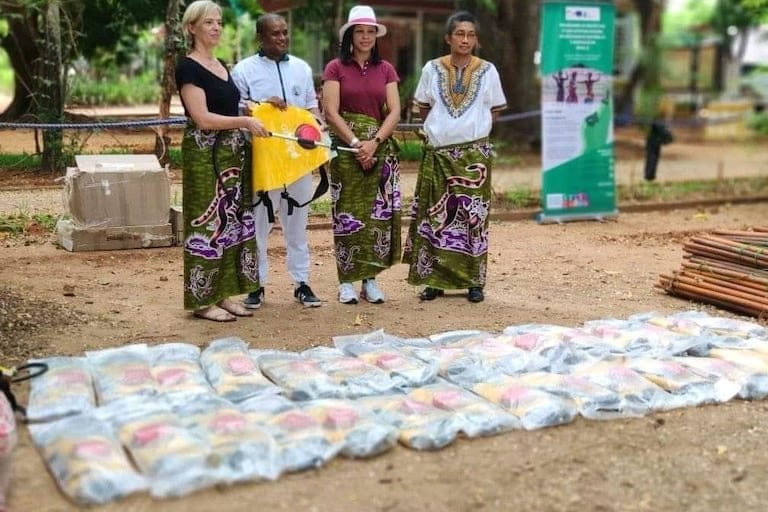
However, law enforcement authorities have at times grown impatience with the educational approach. “We are raising awareness among the people, but that does not seem very effective,” Ihando Andrianjafy, regional director at Madagascar’s Ministry of the Environment, told Radio France Internationale in 2019. “What we are trying to do now is to discourage them by explaining that these fires are punishable by imprisonment.”
The government has a “zero tolerance” police for forest management infractions, such as unauthorized fires. Punitive approaches to conservation do have critics, however. Kull, the geographer, told Mongabay that he couldn’t speak to current practices, but in the past, Madagascar’s fire enforcement was often arbitrary and focused on small-scale actors. He cited the need for clear rules and consistent, fair enforcement, especially around slash-and-burn.
There are no easy answers for conservationists working in Ankarafantsika, but they are pushing for better fire management practices. “This year was the worst [worst year] since we started working in Ankarafantsika in 2015,” Razafitsalama said, referring to the fires. He said there was an urgent need for action to help local people. “If it hasn’t impacted them directly yet, later, it will.”
Citations:
Waeber, P. O., Wilmé, L., Ramamonjisoa, B., Garcia, C., Rakotomalala, D., Rabemananjara, Z. H., … & Sorg, J. P. (2015). Dry forests in Madagascar: neglected and under pressure. International Forestry Review, 17(2), 127-148. DOI:10.1505/146554815815834822
Kun‐Rodrigues, C., Salmona, J., Besolo, A., Rasolondraibe, E., Rabarivola, C., Marques, T. A., & Chikhi, L. (2014). New density estimates of a threatened sifaka species (Propithecus coquereli) in Ankarafantsika National Park. American Journal of Primatology, 76(6), 515-528. DOI: 10.1002/ajp.22243
Kull, C. A. (2002). Madagascar aflame: landscape burning as peasant protest, resistance, or a resource management tool?. Political Geography, 21(7), 927-953. DOI:10.1016/S0962-6298(02)00054-9
Banner image by Rhett Butler/Mongabay
Editor’s note: This story was powered by Places to Watch, a Global Forest Watch (GFW) initiative designed to quickly identify concerning forest loss around the world and catalyze further investigation of these areas. Places to Watch draws on a combination of near-real-time satellite data, automated algorithms and field intelligence to identify new areas on a monthly basis. In partnership with Mongabay, GFW is supporting data-driven journalism by providing data and maps generated by Places to Watch. Mongabay maintains complete editorial independence over the stories reported using this data.
Feedback: Use this form to send a message to the editor of this post. If you want to post a public comment, you can do that at the bottom of the page.
‘Unprecedented’ fires in Madagascar national park threaten livelihoods and lemurs
Source: Trends News

0 Comments